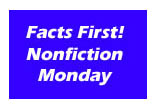I just love Bob Raczka’s books and his take on art.
There is just so much fun, playfulness and creativity imbued in each one that I’m hooked every time.
Unlikely Pairs (750.11 RaU 2006) was the first one to catch my eye and what an eyeful it was, too. Two paintings are displayed on each two-page spread. Typically, the pairs come from different time periods or different mediums and always from different artists, and the connection between the shown subjects always has an element of surprise or irony.
For instance, I really enjoyed the bug-eyed cow (The Cow with the Subtile Nose by Jean Dubeffet, 1954) that is staring (pensively?) at a giant, floor-model hamburger (Floor Burger by Claes Oldenburg, 1962) on the opposite page.
Or a painter (Self-Portrait by Jean-Frederic Bazille, 1986) holding a paint smeared pallet and brushes peering over his shoulder looking at us to see if we are admiring his paint-by-numbers landscape (Do-It-Yourself Landscape by Andy Warhol, 1962). Very funny.
The great interaction between each of the two works really picks up on Raczka’s sense of play. What kid wouldn’t want to find their own unlikely pair? By discussing what makes each pairing work, children have a chance at better understanding the individual works, too.
A more recent book, The Vermeer Interviews: Conversations With Seven Works of Art (759.9492 RaV 2009), had me gripped from the start as he “interviews” characters from seven of Vermeer’s paintings. Effortlessly, we are able to appreciate Vermeer’s artistry and technical ability, as well as learn more about the historical context behind each piece.
For instance, did you know that the woman depicted in Young Woman With a Water Pitcher is wearing a night rail (a white hood with a wide, shoulder length collar) that helps protects her dress as she washes her face during her morning toilette? I didn’t.
Or that by picking up on many subtle details within the painting a narrative starts to build. Looking at The Music Lesson, we begin to see there is a whole lot more going on with furtive glances between student and piano master.
Or that the young (pregnant?) woman intently reading a letter, in the aptly titled painting Woman in Blue Reading a Letter, is possibly yearning for someone traveling (empty chair, map) maybe even her husband. Raczka is clever in helping us decode the piece and yet allows for different interpretations, as well.
The last book I’ll mention is Artful Reading (758.9028 RaA 2008 PIC BK). This is a good one for teaching about the importance of reading (and art, of course). An instructor in the MT program recently read this book aloud to her group of student-teachers to illustrate just this point: that seeing reading depicted as an activity worthy of attention also connotes learning, education, knowledge, wealth, and social status.
Words to live by: “Read all your life and you’ll never be bored”. – Artful Reading by Bob Raczka.
Join Nonfiction Monday Roundup by clicking on the box below to go to Picture Book of the Day blog and see a list of recent blogs dedicated to highlighting nonfiction reading.













